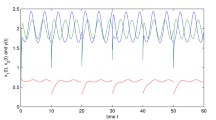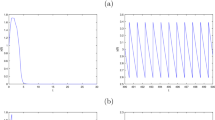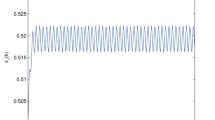Abstract
Discontinuous phenomena appear in various research fields. Impulsive differential equations are often used to model such discontinuous dynamics. This study deals with the Lotka–Volterra predator–prey model dominated by impulsive effects. In the modeling, impulses are added considering the ratios of the interior equilibrium to the current populations of the prey and predator. In this case, there is no restriction of the time interval between the impulse and the next impulse being the same. By focusing on the time interval between impulses adjacent to one another as well as the impulsive effect amount, a simple sufficient condition for the interior equilibrium to become globally asymptotically stable and sufficient conditions that are useful for estimating an attraction region are provided. Our results reveal that impulse control for the Lotka–Volterra predator–prey model can reduce the variation in the population of the prey and predator and enable the stable coexistence of both.






Similar content being viewed by others
Data availability
All data analyzed during this study are included in this article.
References
Bainov, D.D., Simeonov, P.S.: Systems with Impulse Effect: Stability Theory and Applications Ellis. Horwood Ser Mathematics and its Applications. Ellis Horwood Ltd., Chichester (1989)
Bainov, D.D., Simeonov, P.S.: Impulsive Differential Equations: Periodic Solutions and Applications. Pitman Monographs and Surveys in Pure and Applied Mathematics, vol. 66. Longman Scientific & Technical, Harlow (1993)
Bainov, D.D., Simeonov, P.S.: Impulsive Differential Equations, Asymptotic Properties of the Solutions. Series on Advances in Mathematics for Applied Sciences 28. World Scientific Publishing CoPte. Ltd., Singapore (1995)
Barclay, H.J.: Models for pest control using predator release, habitat management and pesticide release in combination. J. Appl. Ecol. 19, 337–348 (1982)
Brauer, F., Nohel, J.A.: The Qualitative Theory of Ordinary Differential Equations. Dover, New York (1989)
Caltagirone, L.E., Doutt, R.L.: The history of the vedalia beetle importation to California and its impact on the development of biological control. Ann. Rev. Entomol. 34, 1–16 (1989)
Coppel, W.A.: Stability and Asymptotic Behavior of Differential Equations. Heath, Boston (1965)
Croft, B.A.: Arthropod Biological Control Agents and Pesticides. John Wiley & Sons Inc., New York (1990)
DeBach, P., Rosen, D.: Biological Control by Natural Enemies, 2nd edn. Cambridge University Press, Cambridge (1991)
Guo, H.-J., Song, X.: An impulsive predator-prey system with modified Leslie-Gower and Holling type II schemes. Chaos Solitons Fractals 36, 1320–1331 (2008)
Israel, G., Gasca, A.M.: The Biology Numbers: The Correspondence of Vito Volterra on Mathematical Biology. Science Networks Historical Studies, vol. 26. Birkhäuser Verlag, Basel (2002)
Karsai, J.: Asymptotic behavior and its visualization of the solutions of intermittently and impulsively damped nonlinear oscillator equations Differential equations and computational simulations II. Appl. Math. Comput. 89, 161–172 (1998)
Kellogg, R.L., Nehring, R., Grube, A., et al.: Environmental indicators of pesticide leaching and runoff from farm fields. In: Ball, V.E., Norton, G.W. (eds.) Agricultural Productivity Measurement and Sources of Growth, pp. 213–256. Kluwer Academic Publishers, Boston (2002)
van Lenteren, J.C., Woets, J.: Biological and integrated pest control in greenhouses. Ann. Rev. Entomol. 33, 239–250 (1988)
Liu, B., Teng, Z., Chen, L.-S.: Analysis of a predator-prey model with Holling II functional response concerning impulsive control strategy. J. Comput. Appl. Math. 193, 347–362 (2006)
Liu, B., Zhang, Y., Chen, L.-S.: The dynamical behaviors of a Lotka-Volterra predator-prey model concerning integrated pest management. Nonlinear Anal. Real World Appl. 6, 227–243 (2005)
Liu, J., Hu, J., Yuen, P.: Extinction and permanence of the predator-prey system with general functional response and impulsive control. Appl. Math. Model. 88, 55–67 (2020)
Lotka, A.J.: Undamped oscillations derived from the laws of mass action. J. Amer. Chem. Soc. 42, 1595–1599 (1920)
Michel, A.N., Hou, L., Liu, D.: Stability Dynamical Systems: Continuous, Discontinuous, and Discrete Systems. Birkhäuser, Boston, Basel, Berlin (2008)
Pei, Y.-Z., Liu, S.-Y., Li, C.-G.: Complex dynamics of an impulsive control system in which predator species share a common prey. J. Nonlinear Sci. 19, 249–266 (2009)
Rouche, N., Habets, P., Laloy, M.: Stability Theory by Liapunov’s Direct Method. Applied Mathematical Sciences, vol. 22. Springer, Berlin (1977)
Sugie, J.: Uniqueness of limit cycles in a predator-prey system with Holling-type functional response. Quart. Appl. Math. 58, 577–590 (2000)
Sugie, J., Katayama, M.: Global asymptotic stability of a predator-prey system of Holling type. Nonlinear Anal. 38, 105–121 (1999)
Sugie, J., Kohno, R., Miyazaki, R.: On a predator-prey system of Holling type. Proc. Amer. Math. Soc. 125, 2041–2050 (1997)
Sugie, J., Miyamoto, K., Morino, K.: Absence of limit cycles of a predator-prey system with a sigmoid functional response. Appl. Math. Lett. 9, 85–90 (1996)
Volterra, V.: Leçons sur la Théorie Mathématique de la Lutte pour la Vie. Gauthier-Villars, Paris (1931)
Wang, X.-Q., Wang, W.-M., Lin, X.-L.: Chaotic behavior of a Watt-type predator-prey system with impulsive control strategy. Chaos Solitons Fractals 37, 706–718 (2008)
Zhang, S., Dong, L.-Z., Chen, L.-S.: The study of predator-prey system with defensive ability of prey and impulsive perturbations on the predator. Chaos Solitons Fractals 23, 631–643 (2005)
Yoshizawa, T.: Stability Theory by Liapunov’s Second Method. Math. Soc. Japan, Tokyo (1966)
Acknowledgements
We would like to thank Editage (www.editage.com ) for their assistance with English language editing.
Funding
The first author’s work was supported in part by Japan Society for the Promotion of Science KAKENHI Grant-in-Aid for Scientific Research (C) [grant number JP20K03701].
Author information
Authors and Affiliations
Corresponding author
Ethics declarations
Conflicts of interest
The authors declare that they have no known competing financial interests or personal relationships that could have appeared to influence the work reported in this paper.
Additional information
Publisher's Note
Springer Nature remains neutral with regard to jurisdictional claims in published maps and institutional affiliations.
Rights and permissions
About this article
Cite this article
Sugie, J., Ishihara, Y. Attraction Region for the Classical Lotka−Volterra Predator−Prey model Caused by impulsive Effects. Qual. Theory Dyn. Syst. 20, 46 (2021). https://doi.org/10.1007/s12346-021-00482-w
Received:
Accepted:
Published:
DOI: https://doi.org/10.1007/s12346-021-00482-w
Keywords
- Global asymptotic stability
- Attraction region
- Impulsive differential equations
- Lotka−Volterra predator−prey model




